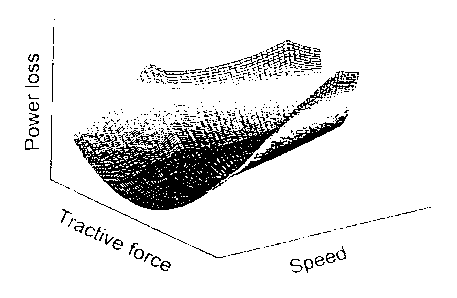Some of the information on this Web page has been provided by external sources. The Government of Canada is not responsible for the accuracy, reliability or currency of the information supplied by external sources. Users wishing to rely upon this information should consult directly with the source of the information. Content provided by external sources is not subject to official languages, privacy and accessibility requirements.
Any discrepancies in the text and image of the Claims and Abstract are due to differing posting times. Text of the Claims and Abstract are posted:
| (12) Patent Application: | (11) CA 2379775 |
|---|---|
| (54) English Title: | METHOD FOR POWER OPTIMIZATION IN A VEHICLE/TRAIN HAVING AN EFFICIENCY THAT DEPENDS ON THE OPERATING POINT |
| (54) French Title: | PROCEDE D'OPTIMISATION DE LA CONSOMMATION ENERGETIQUE POUR UN VEHICULE/TRAIN A RENDEMENT DEPENDANT DU POINT DE TRAVAIL |
| Status: | Deemed Abandoned and Beyond the Period of Reinstatement - Pending Response to Notice of Disregarded Communication |
| (51) International Patent Classification (IPC): |
|
|---|---|
| (72) Inventors : |
|
| (73) Owners : |
|
| (71) Applicants : |
|
| (74) Agent: | SMART & BIGGAR LP |
| (74) Associate agent: | |
| (45) Issued: | |
| (86) PCT Filing Date: | 2000-07-26 |
| (87) Open to Public Inspection: | 2001-02-08 |
| Availability of licence: | N/A |
| Dedicated to the Public: | N/A |
| (25) Language of filing: | English |
| Patent Cooperation Treaty (PCT): | Yes |
|---|---|
| (86) PCT Filing Number: | PCT/EP2000/007152 |
| (87) International Publication Number: | WO 2001008959 |
| (85) National Entry: | 2002-01-28 |
| (30) Application Priority Data: | ||||||
|---|---|---|---|---|---|---|
|
The invention relates to a method for optimizing the energy consumption of a
motor vehicle/train that uses time reserves provided for in a schedule. The
aim of the invention is to improve the operating characteristics of said motor
vehicle/train in such a manner that energy is saved by using an optimization
algorithm. To this end, the correlation between the vehicle efficiency or the
dissipated energy and the operating point is taken into consideration.
Procédé d'optimisation énergétique pour un véhicule/train en cas d'utilisation des temps de réserve prévus par un tableau de marche. Pour parvenir à une manière de rouler économisant de l'énergie à l'aide d'un algorithme d'optimisation, on prend en considération la dépendance existant entre le point de travail et le rendement du véhicule ou la dissipation de puissance.
Note: Claims are shown in the official language in which they were submitted.
Note: Descriptions are shown in the official language in which they were submitted.

2024-08-01:As part of the Next Generation Patents (NGP) transition, the Canadian Patents Database (CPD) now contains a more detailed Event History, which replicates the Event Log of our new back-office solution.
Please note that "Inactive:" events refers to events no longer in use in our new back-office solution.
For a clearer understanding of the status of the application/patent presented on this page, the site Disclaimer , as well as the definitions for Patent , Event History , Maintenance Fee and Payment History should be consulted.
| Description | Date |
|---|---|
| Inactive: IPC from MCD | 2006-03-12 |
| Application Not Reinstated by Deadline | 2005-07-26 |
| Time Limit for Reversal Expired | 2005-07-26 |
| Deemed Abandoned - Failure to Respond to Maintenance Fee Notice | 2004-07-26 |
| Letter Sent | 2003-06-02 |
| Letter Sent | 2003-06-02 |
| Letter Sent | 2003-06-02 |
| Letter Sent | 2003-06-02 |
| Letter Sent | 2003-06-02 |
| Inactive: Single transfer | 2003-04-24 |
| Inactive: Office letter | 2002-08-02 |
| Inactive: Cover page published | 2002-07-24 |
| Inactive: Courtesy letter - Evidence | 2002-07-23 |
| Inactive: Notice - National entry - No RFE | 2002-07-18 |
| Inactive: Applicant deleted | 2002-07-18 |
| Application Received - PCT | 2002-05-07 |
| Inactive: Correspondence - Transfer | 2002-03-01 |
| Inactive: Correspondence - Formalities | 2002-03-01 |
| National Entry Requirements Determined Compliant | 2002-01-28 |
| Application Published (Open to Public Inspection) | 2001-02-08 |
| Abandonment Date | Reason | Reinstatement Date |
|---|---|---|
| 2004-07-26 |
The last payment was received on 2003-06-25
Note : If the full payment has not been received on or before the date indicated, a further fee may be required which may be one of the following
Please refer to the CIPO Patent Fees web page to see all current fee amounts.
| Fee Type | Anniversary Year | Due Date | Paid Date |
|---|---|---|---|
| Basic national fee - standard | 2002-01-28 | ||
| MF (application, 2nd anniv.) - standard | 02 | 2002-07-26 | 2002-07-19 |
| Registration of a document | 2003-04-24 | ||
| MF (application, 3rd anniv.) - standard | 03 | 2003-07-28 | 2003-06-25 |
Note: Records showing the ownership history in alphabetical order.
| Current Owners on Record |
|---|
| BOMBARDIER TRANSPORTATION GMBH |
| Past Owners on Record |
|---|
| CHRISTIAN KLOSE |
| KARL-HERMANN KETTELER |
| MARKUS MEYER |
| PETER TERWIESCH |
| RUDIGER FRANKE |